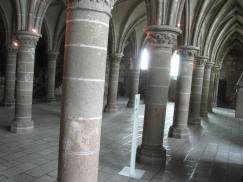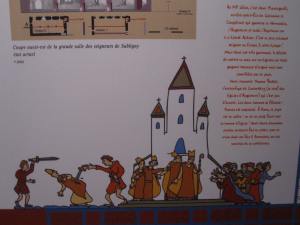The Avranches Scriptorial, also known as the Manuscripts Museum of Mont Saint Michel, is the only museum in France dedicated to medieval manuscripts. I stumbled upon it quite by accident while exploring the town of Avranches, but I strongly encourage other bibliophiles making a trip to Normandy to include the Scriptorial. The displays are beautifully designed and the upper level contains a wealth of information and artifacts related to the creation of books in the Middle Ages.
History
The museum has grown up around a collection of manuscripts taken from Mont-Saint Michel. For those of you who haven’t heard of the Mont, it is a 1000 year old UNESCO world heritage site located on an island between Normandy and Brittany. Founded as an Abby in the 8th century, it remained an important religious site until the French Revolution, when it was gutted and then turned into a prison for political prisoners (fun fact- the former Scriptorium was converted into a cell block during the prison years). During the religious period the Abby’s active scriptorium was the birthplace for numerous manuscripts, all copied by hand and illuminated using colourful dyes and precious metals.
The Museum
The displays fill a long, thin two story building. The first floor explains the history of the Mont, with emphasis on the development of the scriptorium and the library. Cute cartoons help liven up the history section, and the text is interspersed with historical pictures and objects. The second floor delves into the world of the medieval manuscript, with information on the tools, processes, scripts, illuminations, and the individuals who spent years labouring to recreate texts. The end section explains the types of works (religious, philosophical, classical, etc.) which would have been in the abbey and which are currently held by the museum. While all the written information is presented in French, a multilingual audioguide is available from the main desk (unfortunately, the guide only translates a part of the written information).
The final section is the grandly named Treasure Room, which displays a rotating selection from the nearly 200 manuscripts held by the museum. In the treasure room, each volume is opened to a page and some have audioguide numbers which allow you to hear more about the history and content of the work. Although I have seen many pictures of illuminations and manuscripts, it was a very different experience to see them in person; the colours were more vibrant, the gilt illuminations shone, and the texture of the pages were visible, even in low light through the protective case.
The last room before the exit was, of course, the giftshop. I normally wouldn’t mention the souvenir store, but I was excited to discover that they carry a truly unique selection of items in both English and French which relate to the museums content. If you’re interested in caligraphy, writing tools, inks, word games, puzzels, book making or manuscripts, or word-inspired bags and clothing, leave yourself some time (and space in your budget!).



